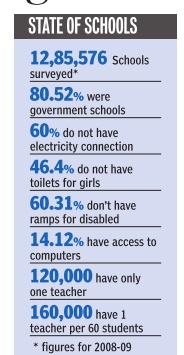
Nine years after the ambitious Sarva Shiksha
Abhiyan (SSA), or education for all programme,
was launched, school infrastructure leaves a
lot to be desired. Teachers and classrooms are
in short supply. Drinking water, electricity
and toilets continue to be a luxury for
primary (Classes I-V) and upper primary
(Classes V-VIII) schools, says a government
report on elementary education.
About 12,85,576 schools were surveyed for
the district information system for education
(DISE) 2008-09 report released by the human
resource development ministry on Friday. Sixty
per cent of the surveyed schools do not have
electricity, while 46.4 per cent don't have
toilets for girls. DISE's mandate is to
maintain the database of schools imparting
elementary education (Classes I-VIII). Most of
the surveyed schools (80 per cent) are
government-run.
Around 120,000 elementary schools are run
by one teacher. The shortage is crowding
classrooms. At least 166,000 schools have one
teacher for 60 pupils. These factors are
pushing up the number of out-of-school
children in the country.
An independent survey commissioned by the
government found 8000,000 children were still
out of school in 2009. The Indian Market
Research Bureau conducted the survey. The
number for 2005 was 1.3 crore. Government
officials take a different view. "The
percentage of schools having toilets for girls
has gone up from 42.58 per cent in 2006-07 to
53.60 per cent. That is a huge increase," said
a ministry official, who didn't wish to be
identified. But, the change has not reflected
in enrolments.
In 2006-07, 48.09 per cent girls were
enrolled in primary classes. The figure
marginally grew to 48.38 in 2008-09. Schools
haven't fared too well on inclusive education.
The report shows that only 40 per cent have
ramps for the physically impaired. While the
Right to Education Act requires not more than
30 students per teacher, in 51,000 primary
schools the ratio is 100 or more pupils per
teacher.
Nine years after the ambitious Sarva Shiksha
Abhiyan (SSA), or education for all
programme, was launched, school
infrastructure leaves a lot to be desired.
Teachers and classrooms are in short supply.
Drinking water, electricity and toilets
continue to be a luxury for primary (Classes
I-V) and upper primary (Classes V-VIII)
schools, says a government report on
elementary education.
About 12,85,576
schools were surveyed for the district
information system for education (DISE)
2008-09 report released by the human
resource development ministry on Friday.
Sixty per cent of the surveyed schools do
not have electricity, while 46.4 per cent
don't have toilets for girls. DISE's mandate
is to maintain the database of schools
imparting elementary education (Classes
I-VIII). Most of the surveyed schools (80
per cent) are government-run.
Around 120,000 elementary schools are run
by one teacher. The shortage is crowding
classrooms. At least 166,000 schools have
one teacher for 60 pupils. These factors are
pushing up the number of out-of-school
children in the country.
An independent survey commissioned by the
government found 8000,000 children were
still out of school in 2009. The Indian
Market Research Bureau conducted the survey.
The number for 2005 was 1.3 crore.
Government officials take a different view.
"The percentage of schools having toilets
for girls has gone up from 42.58 per cent in
2006-07 to 53.60 per cent. That is a huge
increase," said a ministry official, who
didn't wish to be identified. But, the
change has not reflected in enrolments.
In 2006-07, 48.09 per cent girls were
enrolled in primary classes. The figure
marginally grew to 48.38 in 2008-09. Schools
haven't fared too well on inclusive
education. The report shows that only 40 per
cent have ramps for the physically impaired.
While the Right to Education Act requires
not more than 30 students per teacher, in
51,000 primary schools the ratio is 100 or
more pupils per teacher.
